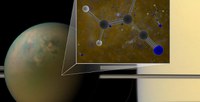Membrane Molecules on Titan
Recent simulations have indicated that vinyl cyanide is the best candidate molecule for the formation of cell membranes/vesicle structures in the hydrocarbon-rich lakes and seas of Titan, Saturn’s moon. Titan is as large Mars, with a hazy atmosphere comprised primarily of nitrogen and a smattering of organic molecules that is possibly similar to Earth’s primordial atmosphere. Although the existence of vinyl cyanide (C2H3CN) on Titan was previously inferred using mass spectrometry from the Cassini spacecraft, a definitive detection has been lacking.
Palmer et al. report the first spectroscopic detection of vinyl cyanide in Titan’s atmosphere, obtained using archival ALMA collected February – May 2014. The authors detected the three strongest rotational lines of C2H3CN in the 230 - 232 GHz frequency range, each with better than 4σ confidence. Radiative transfer modeling suggests that most of the C2H3CN emission originates at altitudes of ≳200 km, in agreement with recent photochemical models. The vertical column densities implied by the best-fit models are in the range of 3.7 × 1013 to 1.4 × 1014 cm−2. The corresponding production rate of vinyl cyanide and its saturation mole fraction imply the availability of sufficient dissolved material to form ~107 cell membranes/cm3 in Titan’s sea, Ligeia Mare.
Image Caption: Archival ALMA data have confirmed that molecules of vinyl cyanide reside in the atmosphere of Titan, Saturn's largest moon. Titan is shown in an optical (atmosphere) infrared (surface) composite from NASA's Cassini spacecraft. In a liquid methane environment, vinyl cyanide may form membranes. Credit: B. Saxton (NRAO/AUI/NSF); NASA.
Publication: Maureen Y. Palmer (NASA-Goddard, St. Olaf College, Catholica University of America) et al., ALMA Detection and Astrobiological Potential of Vinyl Cyanide on Titan, 5 July 2017, Science Advances, Vol. 3, no. 7.





Connect with NRAO